Amanita muscaria: Difference between revisions
No edit summary |
No edit summary |
||
| (35 intermediate revisions by 2 users not shown) | |||
| Line 1: | Line 1: | ||
[[File:flyagarlic1.jpg|400px|left|thumb| [https://www.almanac.com/sites/default/files/styles/or/public/image_nodes/foxglove-shutterstock_656531998.jpg?itok=XBjjszop] | [[File:flyagarlic1.jpg|400px|left|thumb| [https://www.almanac.com/sites/default/files/styles/or/public/image_nodes/foxglove-shutterstock_656531998.jpg?itok=XBjjszop] Amanita muscaria]] | ||
[[Amanita muscaria]], also known as fly | [[Amanita muscaria]], also known as fly agaric, is a basidiomycete fungus native to temperate and boreal regions in the Norther Hemisphere. Amanita muscaria are cosmopolitan species and associates with a variety of deciduous and coniferous trees. Easily recognizable for their iconic toadstool appearance, Amanita muscaria are poisonous and contain psychoactive constituents. | ||
[[File:flyagarlictree.jpg|480px|right|thumb| [http://bioweb.uwlax.edu/bio203/s2009/christia_eri2/Classification.htm]Amanita muscaria phylogenic tree]] | |||
==Taxonomy== | ==Taxonomy== | ||
'''Kingdom:''' Fungi | '''Kingdom:''' Fungi | ||
'''Phylum:''' Basidiomycota | '''Phylum:''' Basidiomycota | ||
| Line 10: | Line 13: | ||
'''Order:''' Agaricales | '''Order:''' Agaricales | ||
'''family:''' Amanitaceae | '''family:''' Amanitaceae | ||
==Overview== | ==Overview== | ||
Amanita muscaria has many variations in regional subspecies which can be distinguished by their environment and physiology. [[#3.|[3]]] These subspecies, also known as variations, were discovered through a molecular phylogenetic study in 2006 by mycologist József Geml. All known variations were shown to be found in Eurasian and North American Amanita muscaria clades, bringing the debate that these variations are simply polymorphisms rather than distinct subspecies.[[#7.|[7]]] | |||
{| class="wikitable" style="margin:auto" | {| class="wikitable" style="margin:auto" | ||
|+ | |+ Amanita muscaria subspecies | ||
|- | |- | ||
! Image !! Scientific name !! Common name !! Description !! | ! Image !! Scientific name !! Common name !! Description !! | ||
|- | |- | ||
| [[File: | | [[File:orange1.jpg|150px|right|thumb| [https://www.almanac.com/sites/default/files/styles/or/public/image_nodes/foxglove-shutterstock_656531998.jpg?itok=XBjjszop]Muscaria var.]] || Amanita muscaria var. muscaria || Euro-Asian fly agaric || The muscaria variation has a bright red cap and originated from northern Europe and Asia. Cap may also be orange or yellow due to slow development of the purple pigment. | ||
|- | |- | ||
| | | [[File:red1.jpg|150px|right|thumb| [https://www.almanac.com/sites/default/files/styles/or/public/image_nodes/foxglove-shutterstock_656531998.jpg?itok=XBjjszop]Flavivolvata var.]] || Amanita muscaria var. flavivolvata || American fly agaric || The flavivolvata variation is red with yellow to yellowish-white warts. It is found from southern Alaska down through Central America, all the way to Andean Colombia. | ||
|- | |- | ||
| | | [[File:yellow1.jpg|150px|right|thumb| [https://www.almanac.com/sites/default/files/styles/or/public/image_nodes/foxglove-shutterstock_656531998.jpg?itok=XBjjszop]Guessowii var.]] || Amanita muscaria var. guessowii || American fly agaric (yellow variant) || The guessowii variation has a yellow to orange cap, with the center often having an orange or red gradient. | ||
|- | |||
| [[File:orangeyellow12.jpg|150px|right|thumb| [https://www.almanac.com/sites/default/files/styles/or/public/image_nodes/foxglove-shutterstock_656531998.jpg?itok=XBjjszop]Inzengae var.]] || Amanita muscaria var. inzengae || Inzenga's fly agaric || The inzengae variation has a pale yellow to orange-yellow cap with yellowish warts and a tan stem. | |||
|} | |} | ||
==Ecology== | ==Ecology== | ||
Fly | Fly agaric has been used historically as a pesticide by combining the mushroom with milk and spraying on plants. The practice of using amanita muscaria for pest management in Germanic and Slavic speaking parts of Europe lead to the fungus claiming the common name "fly agaric" for its ability to kill flies.[[#2.|[2]]] The fruiting season of this mushroom varies dramatically across climates and latitude. Fly agaric is commonly found in a formation known as "fairy rings". This circular formation of mushrooms is a result of the mycelium of the fungus living underground with the fruiting bodies growing around the edge in a circle. [[#1.|[1]]]These fairy rings are subject to much folklore and mythology which has contributed to the recognizability of these toadstool mushrooms. Amanita muscaria can form symbiotic relationships with trees such as pine, oak, spruce, fir, birch, and cedar, and aid in the [[decomposition]] of [[lignin]] and cellulose in conifer and deciduous forest floors.[[#8.|[8]]] | ||
[[File:flyagarlic5.jpg| | [[File:flyagarlic5.jpg|400px|left|thumb| [https://www.almanac.com/sites/default/files/styles/or/public/image_nodes/foxglove-shutterstock_656531998.jpg?itok=XBjjszop]Amanita muscaria fairy ring]] | ||
[[ | ==Psychoactive and cultural uses== | ||
Amanita muscaria contains several active agents which can cause toxic and psychoactive reactions. Muscimol and ibotenic acid are two neurotoxins found in varying doses and ratios within the Amanita muscaria cap.[[#4.|[4]]][[#6.|[6]]] The hallucinogenic effects have been used in Asian and European shamanic rituals across many cultures and it's use in Sibera can be dated to over 16,000 years ago.[[#5.|[5]]] | |||
==References== | |||
1. Australian Government Inititiave . (n.d.). What is a fungus ?. Australian National Herbarium. https://www.anbg.gov.au/fungi/what-is-fungus.html | |||
2. Wasson, R. Gordon. Soma: Divine Mushroom of Immortality. Harcourt Brace Jovanovich, 1973. | |||
3. North Carolina State University. (n.d.). Amanita muscaria. Amanita muscaria (Fly Agaric, Fly Amanita) | North Carolina Extension Gardener Plant Toolbox. https://plants.ces.ncsu.edu/plants/amanita-muscaria/ | |||
4. Satora L, Pach D, Butryn B, Hydzik P, Balicka-Slusarczyk B. Fly agaric (Amanita muscaria) poisoning, case report and review. Toxicon. 2005 Jun 1;45(7):941-3. doi: 10.1016/j.toxicon.2005.01.005. Epub 2005 Apr 14. PMID: 15904689. | |||
5. U.S. Forest Service, USDA. (n.d.). Fly Agaric. Forest Service Shield. https://www.fs.usda.gov/wildflowers/ethnobotany/Mind_and_Spirit/flyagaric.shtml | |||
6. Brvar, M., Možina, M. & Bunc, M. Prolonged psychosis after Amanita muscaria ingestion. Wien Klin Wochenschr 118, 294–297 (2006). https://doi.org/10.1007/s00508-006-0581-6 | |||
7. J. Geml, G. A. Laursen, K. O'Neill, H. C. Nusbaum, D. L. Taylor. Beringian origins and cryptic speciation events in the fly | |||
agaric (Amanita muscaria). Molecular [[Ecology]]. 2006. 15, 225–239. doi: 10.1111/j.1365-294X.2005.02799.x | |||
8. “Amanita Muscaria (L.) Lam., 1783.” GBIF, www.gbif.org/species/113534033. Accessed 6 May 2023. | |||
6. | |||
Latest revision as of 12:16, 10 May 2023
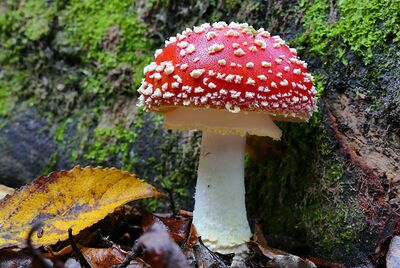
Amanita muscaria, also known as fly agaric, is a basidiomycete fungus native to temperate and boreal regions in the Norther Hemisphere. Amanita muscaria are cosmopolitan species and associates with a variety of deciduous and coniferous trees. Easily recognizable for their iconic toadstool appearance, Amanita muscaria are poisonous and contain psychoactive constituents.
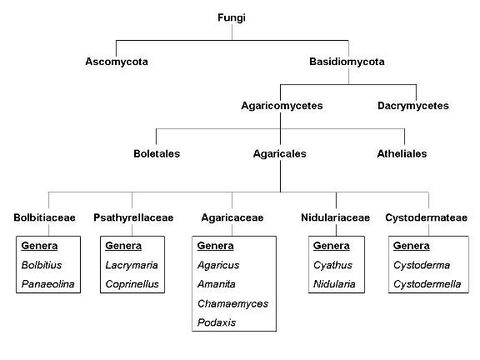
Taxonomy
Kingdom: Fungi
Phylum: Basidiomycota
Class: Agaricomycetes
Order: Agaricales
family: Amanitaceae
Overview
Amanita muscaria has many variations in regional subspecies which can be distinguished by their environment and physiology. [3] These subspecies, also known as variations, were discovered through a molecular phylogenetic study in 2006 by mycologist József Geml. All known variations were shown to be found in Eurasian and North American Amanita muscaria clades, bringing the debate that these variations are simply polymorphisms rather than distinct subspecies.[7]
| Image | Scientific name | Common name | Description | |
|---|---|---|---|---|
 |
Amanita muscaria var. muscaria | Euro-Asian fly agaric | The muscaria variation has a bright red cap and originated from northern Europe and Asia. Cap may also be orange or yellow due to slow development of the purple pigment. | |
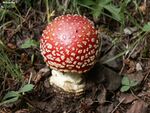 |
Amanita muscaria var. flavivolvata | American fly agaric | The flavivolvata variation is red with yellow to yellowish-white warts. It is found from southern Alaska down through Central America, all the way to Andean Colombia. | |
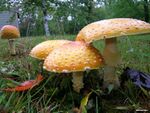 |
Amanita muscaria var. guessowii | American fly agaric (yellow variant) | The guessowii variation has a yellow to orange cap, with the center often having an orange or red gradient. | |
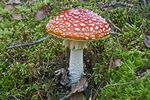 |
Amanita muscaria var. inzengae | Inzenga's fly agaric | The inzengae variation has a pale yellow to orange-yellow cap with yellowish warts and a tan stem. |
Ecology
Fly agaric has been used historically as a pesticide by combining the mushroom with milk and spraying on plants. The practice of using amanita muscaria for pest management in Germanic and Slavic speaking parts of Europe lead to the fungus claiming the common name "fly agaric" for its ability to kill flies.[2] The fruiting season of this mushroom varies dramatically across climates and latitude. Fly agaric is commonly found in a formation known as "fairy rings". This circular formation of mushrooms is a result of the mycelium of the fungus living underground with the fruiting bodies growing around the edge in a circle. [1]These fairy rings are subject to much folklore and mythology which has contributed to the recognizability of these toadstool mushrooms. Amanita muscaria can form symbiotic relationships with trees such as pine, oak, spruce, fir, birch, and cedar, and aid in the decomposition of lignin and cellulose in conifer and deciduous forest floors.[8]

Psychoactive and cultural uses
Amanita muscaria contains several active agents which can cause toxic and psychoactive reactions. Muscimol and ibotenic acid are two neurotoxins found in varying doses and ratios within the Amanita muscaria cap.[4][6] The hallucinogenic effects have been used in Asian and European shamanic rituals across many cultures and it's use in Sibera can be dated to over 16,000 years ago.[5]
References
1. Australian Government Inititiave . (n.d.). What is a fungus ?. Australian National Herbarium. https://www.anbg.gov.au/fungi/what-is-fungus.html
2. Wasson, R. Gordon. Soma: Divine Mushroom of Immortality. Harcourt Brace Jovanovich, 1973.
3. North Carolina State University. (n.d.). Amanita muscaria. Amanita muscaria (Fly Agaric, Fly Amanita) | North Carolina Extension Gardener Plant Toolbox. https://plants.ces.ncsu.edu/plants/amanita-muscaria/
4. Satora L, Pach D, Butryn B, Hydzik P, Balicka-Slusarczyk B. Fly agaric (Amanita muscaria) poisoning, case report and review. Toxicon. 2005 Jun 1;45(7):941-3. doi: 10.1016/j.toxicon.2005.01.005. Epub 2005 Apr 14. PMID: 15904689.
5. U.S. Forest Service, USDA. (n.d.). Fly Agaric. Forest Service Shield. https://www.fs.usda.gov/wildflowers/ethnobotany/Mind_and_Spirit/flyagaric.shtml
6. Brvar, M., Možina, M. & Bunc, M. Prolonged psychosis after Amanita muscaria ingestion. Wien Klin Wochenschr 118, 294–297 (2006). https://doi.org/10.1007/s00508-006-0581-6
7. J. Geml, G. A. Laursen, K. O'Neill, H. C. Nusbaum, D. L. Taylor. Beringian origins and cryptic speciation events in the fly agaric (Amanita muscaria). Molecular Ecology. 2006. 15, 225–239. doi: 10.1111/j.1365-294X.2005.02799.x
8. “Amanita Muscaria (L.) Lam., 1783.” GBIF, www.gbif.org/species/113534033. Accessed 6 May 2023.